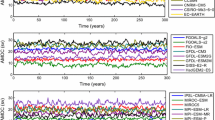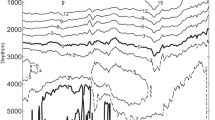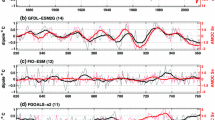Abstract
A wide range of statistical tools is used to investigate the decadal variability of the Atlantic Meridional Overturning Circulation (AMOC) and associated key variables in a climate model (CHIME, Coupled Hadley-Isopycnic Model Experiment), which features a novel ocean component. CHIME is as similar as possible to the 3rd Hadley Centre Coupled Model (HadCM3) with the important exception that its ocean component is based on a hybrid vertical coordinate. Power spectral analysis reveals enhanced AMOC variability for periods in the range 15–30 years. Strong AMOC conditions are associated with: (1) a Sea Surface Temperature (SST) anomaly pattern reminiscent of the Atlantic Multi-decadal Oscillation (AMO) response, but associated with variations in a northern tropical-subtropical gradient; (2) a Surface Air Temperature anomaly pattern closely linked to SST; (3) a positive North Atlantic Oscillation (NAO)-like pattern; (4) a northward shift of the Intertropical Convergence Zone. The primary mode of AMOC variability is associated with decadal changes in the Labrador Sea and the Greenland Iceland Norwegian (GIN) Seas, in both cases linked to the tropical activity about 15 years earlier. These decadal changes are controlled by the low-frequency NAO that may be associated with a rapid atmospheric teleconnection from the tropics to the extratropics. Poleward advection of salinity anomalies in the mixed layer also leads to AMOC changes that are linked to processes in the Labrador Sea. A secondary mode of AMOC variability is associated with interannual changes in the Labrador and GIN Seas, through the impact of the NAO on local surface density.


















Similar content being viewed by others
References
Alekseev GV, Johannessen OM, Korablev AA, Ivanov VV, Kovalesky DV (2001) Interannual variability of water mass in the Greenland Sea and the adjacent areas. Polar Res 20:207–210
Belkin IM, Levitus S, Antonov JI, Malmberg SA (1998) “Great Salinity Anomalies” in the North Atlantic. Prog Oceanogr 41:1–68
Bentsen M, Drange H, Furevik T, Zhou T (2004) Simulated variability of the Atlantic meridional overturning circulation. Clim Dyn 22. doi:10.1007/s00382-004-0397-x
Biastoch A, Böning CW, Lutjeharms JRE (2008) Agulhas leakage dynamics affects decadal variability in Atlantic overturning circulation. Nature 456:489–492. doi:10.1038/nature07426
Biastoch A, Böning CW, Schwarzkopf FU, Lutjeharms JRE (2009) Increase in Agulhas leakage due to poleward shift in the southern hemisphere westerlies. Nature 462:495–498. doi:10.1038/nature08519
Biasutti M, Sobel AH, Kushnir Y (2006) GCM precipitation biases in the tropical Atlantic. J Clim 19:935–958
Bingham RJ, Hughes CW, Roussenov V, Williams RG (2007) Meridional coherence of the North Atlantic meridional overturning circulation. Geophys Res Lett 34:L23606. doi:10.1029/2007GL031731
Bleck R (2002) An oceanic general circulation model framed in hybrid isopycnic-Cartesian coordinates. Ocean Mod 4:55–88
Chatfield C (1975) The analysis of timeseries: theory and practice. Chapman and Hall, London
Chiang JC, Kushnir Y, Giannini A (2002) Deconstructing Atlantic intertropical convergence zone variability: influence of the local cross-equatorial sea surface temperature gradient and remote forcing from the eastern equatorial Pacific. Geophys Res Lett 107:4004. doi:10.1029/2000JD000307
Colin de Verdière A, Huck T (1999) Baroclinic instability: an oceanic wavemaker for interdecadal variability. J Phys Oceanogr 29:893–910
Curry RG, McCartney MS, Joyce TM (1998) Oceanic transport of subpolar climate signals to mid-depth subtropical waters. Nature 391:575–577
Dai A, Hu A, Meehl GA, Washington WM, Strand WG (2005) Atlantic thermohaline circulation in a coupled general circulation model: unforced variations versus forced changes. J Clim 18:3270–3293
Danabasoglu G (2008) On multi-decadal variability of the Atlantic meridional overturning circulation in the Community Climate System Model Version 3 (CCSM3). J Clim 24:5524–5544
Delworth TL, Greatbatch RJ (2000) Multidecadal thermohaline circulation variability driven by atmospheric surface flux forcing. J Clim 13:1481–1495
Delworth TL, Mann ME (2000) Observed and simulated multi-decadal variability in the Northern Hemisphere. Clim Dyn 16:661–676
Delworth TL, Manabe S, Stouffer RJ (1993) Interdecadal variations of the thermohaline circulation in a coupled ocean-atmosphere model. J Clim 6:1993–2011
Dickson RR, Lazier J, Meincke J, Rhines P, Swift J (1996) Long-term coordinated changes in the convective activity of the North Atlantic. Prog Oceanogr 38:241–295
Dong B, Sutton RT (2005) Mechanism of interdecadal thermohaline circulation variability in a coupled ocean- atmosphere GCM. J Climate 18:1117–1135
Eden C, Willebrand J (2001) Mechanism of interannual to decadal variability of the North Atlantic Circulation. J Clim 14:2266–2280
Fan M, Schneider EK (2012) Observed decadal North Atlantic tripole SST variability. Part I: weather noise forcing and coupled response. J Atmos Sci 69:35–50
Frankcombe LH, Dijkstra HA, von der Heydt A (2008) Sub-surface signatures of the Atlantic multidecadal oscillation. Geophys Res Lett 35:L19602. doi:10.1029/2008GL034989
Frankcombe LH, von der Heydt A, Dijkstra HA (2010) North Atlantic multidecadal climate variability: an investigation of dominant time scales and processes. J Clim 23:3626–3638
Ganachaud A, Wunsch C (2000) Improved estimates of global ocean circulation, heat transport and mixing from hydrographic data. Nature 408:453–457
Gordon AL, Zebiak SE, Bryan K (1992) Climate variability and the Atlantic Ocean. Eos Trans AGU 73:161–165
Gordon C, Cooper C, Senior CA, Banks H, Gregory JM, Johns TC, Mitchell JFB, Wood RA (2000) The simulation of SST, sea ice extents and ocean heat transports in a version of the Hadley Centre coupled model without flux adjustments. Clim Dyn 16:147–168
Gregory JM et al (2005) A model intercomparison of changes in the Atlantic thermohaline circulation in response to increasing atmospheric CO2 concentration. Geophys Res Lett 32:L12703. doi:10.1029/2005GL023209
Guemas V, Salas-Mélia D (2008) Simulation of the Atlantic meridional overturning circulation in an atmosphere–ocean global coupled model. Part I: a mechanism governing the variability of ocean convection in a preindustrial experiment. Clim Dyn 31:29–48
Hawkins E, Sutton R (2007) Variability of the Atlantic thermohaline circulation described by three-dimensional empirical orthogonal functions. Clim Dyn 29:745–762
Herweijer C, Seager R, Winton M, Clement A (2005) Why the ocean heat tranport warms the global mean climate. Tellus 57A:662–675
Hurrell JW, Dickson RR (2004) Climate variability over the North Atlantic. In: Stenseth NC et al (eds) Marine ecosystems and climate variation. Oxford University Press, Oxford, pp 15–31
Jungclaus J, Haak H, Latif M, Mikolajewicz U (2005) Arctic-North Atlantic interactions and multidecadal variability of the meridional overturning circulation. J Clim 18:4013–4031
Kerr RA (2000) A North Atlantic climate pacemaker for the centuries. Science 288:1984–1985
Knight JR, Allan RJ, Folland CK, Vellinga M, Mann ME (2005) A signature of persistent natural thermohaline circulation cycles in observed climate. Geophys Res Lett 32:L20708. doi:10.1029/2005GL024233
Latif M, Roeckner E, Botzet M, Esch M, Haak H, Hagemann S, Jungclaus J, Legutke S, Marsland S (2004) Reconstructing, monitoring, and predicting multidecadal-scale changes in the North Atlantic thermohaline circulation with sea surface temperature. J Clim 17:1605–1614
Latif M, Collins M, Pohlmann H, Keenlyside N (2006) A review of predictability studies of Atlantic sector climate on decadal time scales. J Clim 19:5971–5986
Levitus S (1998) World Ocean Atlas, US Department of Commerce
Megann AP, New AL, Blaker AT, Sinha B (2010) The sensitivity of a coupled climate model to its ocean component. J Climate 23:5126–5150
Megann AP, New AL, Blaker AT (2012) The effect of interannual-timescale salinity anomalies on the stability of the Atlantic meridional overturning circulation. Clim Dyn (under review)
Mignot J, Frankignoul C (2005) The variability of the Atlantic meridional overturning circulation, the north atlantic oscillation, and the el nino southern oscillation in the Bergen climate model. J Clim 18(13):2361–2375
Mignot J, Frankignoul C (2009) Local and remote impacts of a tropical Atlantic salinity anomaly. Clim Dyn. doi: 10.1007/s00382-009-0621-9
Okumura Y, Xie SP, Numaguti A, Tanimoto Y (2001) Tropical Atlantic air–sea interaction and its influence on the NAO. Geophys Res Lett 28:1507–1510
Pickart RS, Spall MA, Ribergaard MH, Moore GWK, Milliff RF (2003) Deep convection in the Irminger Sea forced by the Greenland tip jet. Nature 424:152–156
Pohlmann H, Sienz F, Latif M (2006) Influence of the multidecadal Atlantic meridional overturning circulation variability on European climate. J Clim 19:6062–6067
Rajagopalan B, Kushnir Y, Tourre YM (1998) Observed mid-latitude and tropical Atlantic climate variability. Geophys Res Lett 25:3967–3970
Reid JL (1989) On the total geostrophic circulation of the South Atlantic Ocean: flow patterns, tracers, and transports. Prog Oceanogr 23:149–244
Roberts MJ, Marsh R, New AL, Wood RA (1996) An intercomparison of a Bryan-Cox type ocean model and an isopycnic ocean model. Part I: the subpolar gyre and high latitude processes. J Phys Oceanogr 26:1495–1527
Santer BD, Wigley TML, Barnett TP, Anyamba E (1996) Detection of climate change and attribution of causes. In: Callander BA, Harris N, Kattenberg A, Houghton JT, Meira Filho LG (eds) Climate change 1995. The IPCC second scientific assessment. Cambridge University Press, Cambridge, pp 407–444
Schmitz WJ Jr, Richardson PL (1991) On the sources of the Florida current. Deep-Sea Res 38(Suppl 1):S389–S409
Schneider EK, Fan M (2007) Weather noise forcing of surface climate variability. J Atmos Sci 64:3265–3280
Sun S, Bleck R (2001) Thermohaline circulation studies with an isopycnic coordinate ocean model. J Phys Oceanogr 31:2761–2782
Sutton RT, Hodson DLR (2005) Atlantic Ocean forcing of North American and European summer climate. Science 309:115–118
Sutton RT, Norton WA, Jewson SP (2001) The North Atlantic Oscillation—what role for the ocean? Atmos Sci Lett 1(2). doi: 10.1006/asle.2000.0018
Talley LD (2003) Shallow, intermediate, and deep overturning components of the global heat budget. J Phys Oceanogr 6333:530–560
te Raa LA, Dijkstra HA (2002) Instability of the thermohaline circulation on interdecadal timescales. J Phys Oceanogr 32:138–160
Terray L, Cassou C (2002) Tropical atlantic sea surface temperature forcing of the quasi-decadal climate variability over the north Atlantic-Europe region. J Clim 15:3170–3187
Timmerman A, Latif M, Voss R, Grötzner A (1998) Northern Hemisphere interdecadal variability. J Clim 11:1906–1931
Vellinga M, Wu P (2004) Low-latitude freshwater influence on centennial variability of the Atlantic thermohaline circulation. J Clim 17:4498–4511
Visbeck MH, Hurrell JW, Polvani L, Cullen HM (2001) The North Atlantic oscillation: past, present, and future. Proc Natl Acad Sci USA 98:12876–12877
Von Storch H, Zwiers FW (1999) Statistical analysis in climate research. Cambridge University Press, Cambridge, p 494
Winton M (2003) On the climatic impact of ocean circulation. J Clim 16:2875–2889
Acknowledgments
This work is funded under the “Strategic Ocean Funding Initiative” (SOFI) of the NERC Oceans 2025 research programme (Grant # NE/F012241/1). We also acknowledge the RAPID-THCMIP project. The authors are grateful to Juliette Mignot, Eric Guilyardi and Claude Frankignoul at LOCEAN (Institut Pierre-Simon Laplace, Jussieu, Paris) for their useful comments. We finally thank the editor and two anonymous reviewers for insightful remarks and constructive suggestions that led to substantial improvement of the manuscript.
Author information
Authors and Affiliations
Corresponding author
Rights and permissions
About this article
Cite this article
Persechino, A., Marsh, R., Sinha, B. et al. Decadal-timescale changes of the Atlantic overturning circulation and climate in a coupled climate model with a hybrid-coordinate ocean component. Clim Dyn 39, 1021–1042 (2012). https://doi.org/10.1007/s00382-012-1432-y
Received:
Accepted:
Published:
Issue Date:
DOI: https://doi.org/10.1007/s00382-012-1432-y




